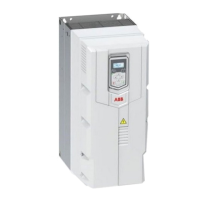410 Fault tracing
Faults latch inside the drive and cause the drive to trip, and the motor stops. After the
cause of a fault has been removed, the fault can be reset from a selectable source
(parameter 31.11 Fault reset selection) such as the control panel, Drive composer PC
tool, the digital inputs of the drive, or fieldbus. Reseting the fault creates an event
64FF Fault reset. After the reset, the drive can be restarted.
Note that some faults require a reboot of the control unit either by switching the power
off and on, or using parameter 96.08 Control board boot – this is mentioned in the
fault listing wherever appropriate.
Pure events
In addition to warnings and faults, there are pure events that are only recorded in the
event log of the drive. The codes of these events are included in the Warning
messages table on page (412).
Editable messages
For external events, the action (fault or warning), name and the message text can be
edited. To specify external events, use parameter 31 Fault functions.
Warning/fault history
Event log
All indications are stored in the event log with a time stamp and other information.
The event log stores information on
• the last 8 fault recordings, that is, faults that tripped the drive or fault resets
• the last 10 warnings or pure events that occurred.
See section Viewing warning/fault information on page 410.
Auxiliary codes
Some events generate an auxiliary code that often helps in pinpointing the problem.
On the control panel, the auxiliary code is stored as part of the details of the event; in
the Drive composer PC tool, the auxiliary code is shown in the event listing.
Viewing warning/fault information
The drive is able to store a list of the active faults actually causing the drive to trip at
the present time. The drive also stores a list of faults and warnings that have
previously occurred.
For active faults and warnings, see
• Menu - Diagnostics
- Active faults
• Menu - Diagnostics
- Active warnings
• parameters in group 04 Warnings and faults (page 169).

